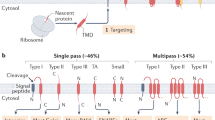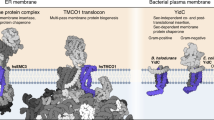Abstract
Integral membrane proteins are generally believed to have unique membrane topologies. However, it has been suggested that dual-topology proteins that adopt a mixture of two opposite orientations in the membrane may exist. Here we show that the membrane orientations of five dual-topology candidates identified in Escherichia coli are highly sensitive to changes in the distribution of positively charged residues, that genes in families containing dual-topology candidates occur in genomes either as pairs or as singletons and that gene pairs encode two oppositely oriented proteins whereas singletons encode dual-topology candidates. Our results provide strong support for the existence of dual-topology proteins and shed new light on the evolution of membrane-protein topology and structure.
This is a preview of subscription content, access via your institution
Access options
Subscribe to this journal
Receive 12 print issues and online access
$189.00 per year
only $15.75 per issue
Buy this article
- Purchase on Springer Link
- Instant access to full article PDF
Prices may be subject to local taxes which are calculated during checkout




Similar content being viewed by others
References
Nilsson, I.M. & von Heijne, G. Fine-tuning the topology of a polytopic membrane protein. Role of positively and negatively charged residues. Cell 62, 1135–1141 (1990).
Gafvelin, G. & von Heijne, G. Topological “frustration” in multi-spanning E. coli inner membrane proteins. Cell 77, 401–412 (1994).
Ubarretxena-Belandia, I., Baldwin, J.M., Schuldiner, S. & Tate, C.G. Three-dimensional structure of the bacterial multidrug transporter EmrE shows it is an asymmetric homodimer. EMBO J. 22, 6175–6181 (2003).
Ma, C. & Chang, G. Structure of the multidrug resistance efflux transporter EmrE from Escherichia coli. Proc. Natl. Acad. Sci. USA 101, 2852–2857 (2004).
Ninio, S., Elbaz, Y. & Schuldiner, S. The membrane topology of EmrE—a small multidrug transporter from Escherichia coli. FEBS Lett. 562, 193–196 (2004).
Daley, D.O. et al. Global topology analysis of the Escherichia coli inner membrane proteome. Science 308, 1321–1323 (2005).
Paulsen, I.T. et al. The SMR family: a novel family of multidrug efflux proteins involved with the efflux of lipophilic drugs. Mol. Microbiol. 19, 1167–1175 (1996).
Sand, O., Gingras, M., Beck, N., Hall, C. & Trun, N. Phenotypic characterization of overexpression or deletion of the Escherichia coli crcA, cspE and crcB genes. Microbiology 149, 2107–2117 (2003).
von Heijne, G. The distribution of positively charged residues in bacterial inner membrane proteins correlates with the trans-membrane topology. EMBO J. 5, 3021–3027 (1986).
von Heijne, G. Control of topology and mode of assembly of a polytopic membrane protein by positively charged residues. Nature 341, 456–458 (1989).
Whitley, P., Nilsson, I. & von Heijne, G. De novo design of integral membrane proteins. Nat. Struct. Biol. 1, 858–862 (1994).
Nishino, K. & Yamaguchi, A. Analysis of a complete library of putative drug transporter genes in Escherichia coli. J. Bacteriol. 183, 5803–5812 (2001).
Sääf, A., Johansson, M., Wallin, E. & von Heijne, G. Divergent evolution of membrane protein topology: The Escherichia coli RnfA and RnfE homologues. Proc. Natl. Acad. Sci. USA 96, 8540–8544 (1999).
Manoil, C. & Beckwith, J. A genetic approach to analyzing membrane protein topology. Science 233, 1403–1408 (1986).
Feilmeier, B.J., Iseminger, G., Schroeder, D., Webber, H. & Phillips, G.J. Green fluorescent protein functions as a reporter for protein localization in Escherichia coli. J. Bacteriol. 182, 4068–4076 (2000).
Bateman, A. et al. The Pfam protein families database. Nucleic Acids Res. 32, D138–D141 (2004).
Sääf, A., Baars, L. & von Heijne, G. The internal repeats in the Na+/Ca2+ exchanger-related Escherichia coli protein YrbG have opposite membrane topologies. J. Biol. Chem. 276, 18905–18907 (2001).
Shimizu, T., Mitsuke, H., Noto, K. & Arai, M. Internal gene duplication in the evolution of prokaryotic transmembrane proteins. J. Mol. Biol. 339, 1–15 (2004).
Walz, T. et al. The three-dimensional structure of aquaporin-1. Nature 387, 624–627 (1997).
Fu, D. et al. Structure of a glycerol-conducting channel and the basis for its selectivity. Science 290, 481–486 (2000).
van den Berg, B. et al. X-ray structure of a protein-conducting channel. Nature 427, 36–44 (2004).
Dutzler, R., Campbell, E.B., Cadene, M., Chait, B.T. & MacKinnon, R. X-ray structure of a ClC chloride channel at 3.0 Å reveals the molecular basis of anion selectivity. Nature 415, 287–294 (2002).
Yamashita, A., Singh, S.K., Kawate, T., Jin, Y. & Gouaux, E. Crystal structure of a bacterial homologue of Na+/Cl− -dependent neurotransmitter transporters. Nature 437, 215–223 (2005).
Pornillos, O., Chen, Y.J., Chen, A.P. & Chang, G. X-ray structure of the EmrE multidrug transporter in complex with a substrate. Science 310, 1950–1953 (2005).
Rapp, M. et al. Experimentally based topology models for E. coli inner membrane proteins. Protein Sci. 13, 937–945 (2004).
Ho, S.N., Hunt, H.D., Horton, R.M., Pullen, J.K. & Pease, L.R. Site-directed mutagenesis by overlap extension using the polymerase chain reaction. Gene 77, 51–59 (1989).
Lee, E. & Manoil, C. Mutations eliminating the protein export function of a membrane-spanning sequence. J. Biol. Chem. 269, 28822–28828 (1994).
Studier, F.W., Rosenberg, A.H., Dunn, J.J. & Dubendorff, J.W. Use of T7 RNA polymerase to direct expression of cloned genes. Methods Enzymol. 185, 60–89 (1990).
Thompson, J.D., Higgins, D.G. & Gibson, T.J. CLUSTAL W: Improving the sensitivity of progressive multiple sequence alignment through sequence weighting, position-specific gap penalties and weight matrix choice. Nucleic Acids Res. 22, 4673–4680 (1994).
Krogh, A., Larsson, B., von Heijne, G. & Sonnhammer, E. Predicting transmembrane protein topology with a hidden Markov model. Application to complete genomes. J. Mol. Biol. 305, 567–580 (2001).
Melén, K., Krogh, A. & von Heijne, G. Reliability measures for membrane protein topology prediction algorithms. J. Mol. Biol. 327, 735–744 (2003).
Granseth, E., Daley, D.O., Rapp, M., Melén, K. & von Heijne, G. Experimentally constrained topology models for 51,208 bacterial inner membrane proteins. J. Mol. Biol. 352, 489–494 (2005).
Needleman, S.B. & Wunsch, C.D. A general method applicable to the search for similarities in the amino acid sequence of two proteins. J. Mol. Biol. 48, 444–453 (1970).
Altschul, S.F., Gish, W., Miller, W., Myers, E.W. & Lipman, D.J. Basic local alignment search tool. J. Mol. Biol. 215, 403–410 (1990).
Altschul, S.F. et al. Gapped BLAST and PSI-BLAST: a new generation of protein database search programs. Nucleic Acids Res. 25, 3389–3402 (1997).
Acknowledgements
This work was supported by grants from the Swedish Foundation for Strategic Research, the Swedish Research Council, the Swedish Cancer Foundation, the Marianne and Marcus Wallenberg Foundation and the European Commission (BioSapiens) to G.v.H.
Author information
Authors and Affiliations
Corresponding author
Ethics declarations
Competing interests
The authors declare no competing financial interests.
Supplementary information
Supplementary Table 1
The 174 genome sequences used in the Pfam-based searches for homologs to the E. coli proteins analysed in the main paper. (PDF 94 kb)
Supplementary Table 2
Homologs to the different protein families found in the Pfam searches. (PDF 1575 kb)
Rights and permissions
About this article
Cite this article
Rapp, M., Granseth, E., Seppälä, S. et al. Identification and evolution of dual-topology membrane proteins. Nat Struct Mol Biol 13, 112–116 (2006). https://doi.org/10.1038/nsmb1057
Received:
Accepted:
Published:
Issue Date:
DOI: https://doi.org/10.1038/nsmb1057
This article is cited by
-
A topology framework for macromolecular complexes and condensates
Nano Research (2022)
-
Structure and dynamics of the drug-bound bacterial transporter EmrE in lipid bilayers
Nature Communications (2021)
-
Transporter proteins in Zymomonas mobilis contribute to the tolerance of lignocellulose-derived phenolic aldehyde inhibitors
Bioprocess and Biosystems Engineering (2021)
-
Lipid-Assisted Membrane Protein Folding and Topogenesis
The Protein Journal (2019)
-
Measuring the Conformational Distance of GPCR-related Proteins Using a Joint-based Descriptor
Scientific Reports (2017)



